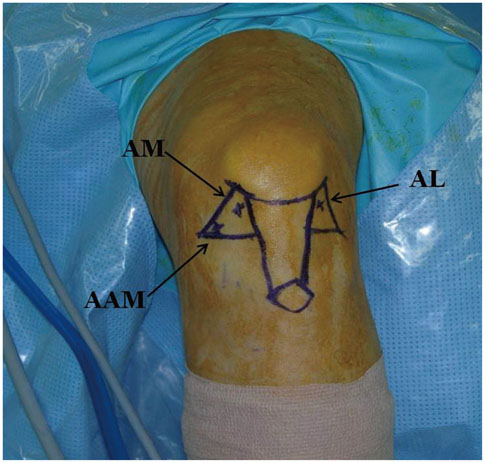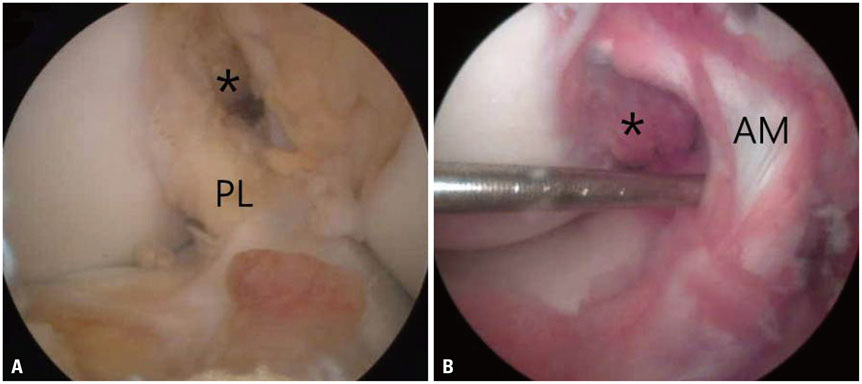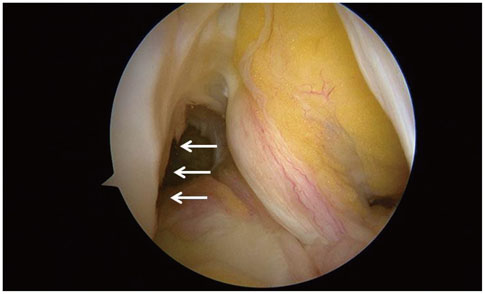Yonsei Med J.
2016 Sep;57(5):1199-1208. 10.3349/ymj.2016.57.5.1199.
A Comparison between Clinical Results of Selective Bundle and Double Bundle Anterior Cruciate Ligament Reconstruction
- Affiliations
-
- 1Department of Orthopedic Surgery, Hallym University Dongtan Sacred Heart Hospital, Hwaseong, Korea. yjseoos@gmail.com
- 2HiLab, Korea University of Technology and Education, Cheonan, Korea.
- KMID: 2374166
- DOI: http://doi.org/10.3349/ymj.2016.57.5.1199
Abstract
- PURPOSE
The purpose of this study was to compare the clinical outcomes of arthroscopic anatomical double bundle (DB) anterior cruciate ligament (ACL) reconstruction with either selective anteromedial (AM) or posterolateral (PL) bundle reconstruction while preserving a relatively healthy ACL bundle.
MATERIALS AND METHODS
The authors evaluated 98 patients with a mean follow-up of 30.8±4.0 months who had undergone DB or selective bundle ACL reconstructions. Of these, 34 cases underwent DB ACL reconstruction (group A), 34 underwent selective AM bundle reconstruction (group B), and 30 underwent selective PL bundle reconstructions (group C). These groups were compared with respect to Lysholm and International Knee Documentation Committee (IKDC) score, side-to-side differences of anterior laxity measured by KT-2000 arthrometer at 30 lbs, and stress radiography and Lachman and pivot shift test results. Pre- and post-operative data were objectively evaluated using a statistical approach.
RESULTS
The preoperative anterior instability measured by manual stress radiography at 90° of knee flexion in group A was significantly greater than that in groups B and C (all p<0.001). At last follow-up, mean side-to-side instrumented laxities measured by the KT-2000 and manual stress radiography were significantly improved from preoperative data in all groups (all p<0.001). There were no significant differences between the three groups in anterior instability measured by KT-2000 arthrometer, pivot shift, or functional scores.
CONCLUSION
Selective bundle reconstruction in partial ACL tears offers comparable clinical results to DB reconstruction in complete ACL tears.
MeSH Terms
Figure
Cited by 1 articles
-
Clinical Results of Footprint Restoration Anterior Cruciate Ligament Reconstruction with Remnant Preservation
Hyun-Min Chung, Young-Jin Seo, Si Young Song, Myoungsoo Cha
J Korean Orthop Assoc. 2019;54(6):537-546. doi: 10.4055/jkoa.2019.54.6.537.
Reference
-
1. Adachi N, Ochi M, Uchio Y, Iwasa J, Ryoke K, Kuriwaka M. Mechanoreceptors in the anterior cruciate ligament contribute to the joint position sense. Acta Orthop Scand. 2002; 73:330–334.
Article2. Arnoczky SP. Anatomy of the anterior cruciate ligament. Clin Orthop Relat Res. 1983; (172):19–25.
Article3. Buoncristiani AM, Tjoumakaris FP, Starman JS, Ferretti M, Fu FH. Anatomic double-bundle anterior cruciate ligament reconstruction. Arthroscopy. 2006; 22:1000–1006.
Article4. Fu FH, Bennett CH, Ma CB, Menetrey J, Lattermann C. Current trends in anterior cruciate ligament reconstruction. Part II. Operative procedures and clinical correlations. Am J Sports Med. 2000; 28:124–130.
Article5. Ochi M, Adachi N, Uchio Y, Deie M, Kumahashi N, Ishikawa M, et al. A minimum 2-year follow-up after selective anteromedial or posterolateral bundle anterior cruciate ligament reconstruction. Arthroscopy. 2009; 25:117–122.
Article6. Ochi M, Iwasa J, Uchio Y, Adachi N, Kawasaki K. Induction of somatosensory evoked potentials by mechanical stimulation in reconstructed anterior cruciate ligaments. J Bone Joint Surg Br. 2002; 84:761–766.
Article7. Pombo MW, Shen W, Fu FH. Anatomic double-bundle anterior cruciate ligament reconstruction: where are we today? Arthroscopy. 2008; 24:1168–1177.
Article8. Woo SL, Debski RE, Withrow JD, Janaushek MA. Biomechanics of knee ligaments. Am J Sports Med. 1999; 27:533–543.
Article9. Xerogeanes JW, Fox RJ, Takeda Y, Kim HS, Ishibashi Y, Carlin GJ, et al. A functional comparison of animal anterior cruciate ligament models to the human anterior cruciate ligament. Ann Biomed Eng. 1998; 26:345–352.
Article10. Yagi M, Wong EK, Kanamori A, Debski RE, Fu FH, Woo SL. Biomechanical analysis of an anatomic anterior cruciate ligament reconstruction. Am J Sports Med. 2002; 30:660–666.
Article11. Yoo YS, Jeong WS, Shetty NS, Ingham SJ, Smolinski P, Fu F. Changes in ACL length at different knee flexion angles: an in vivo biomechanical study. Knee Surg Sports Traumatol Arthrosc. 2010; 18:292–297.
Article12. Zantop T, Brucker PU, Vidal A, Zelle BA, Fu FH. Intraarticular rupture pattern of the ACL. Clin Orthop Relat Res. 2007; 454:48–53.
Article13. Gadikota HR, Hosseini A, Asnis P, Li G. Kinematic analysis of five different anterior cruciate ligament reconstruction techniques. Knee Surg Relat Res. 2015; 27:69–75.
Article14. Sim JA, Lee YS, Kim KO, Kim JK, Lee BK. Anatomic double-bundle anterior cruciate ligament reconstruction using an outside-in technique: two- to six-year clinical and radiological follow-up. Knee Surg Relat Res. 2015; 27:34–42.
Article15. Siebold R, Ellert T, Metz S, Metz J. Tibial insertions of the anteromedial and posterolateral bundles of the anterior cruciate ligament: morphometry, arthroscopic landmarks, and orientation model for bone tunnel placement. Arthroscopy. 2008; 24:154–161.
Article16. Lee SH, Choi JY, Kim DH, Kang BJ, Nam DC, Yoon HK, et al. Correlation between femoral guidewire position and tunnel communication in double bundle anterior cruciate ligament reconstruction. Yonsei Med J. 2014; 55:1592–1599.
Article17. Kim HS, Seon JK, Jo AR. Current trends in anterior cruciate ligament reconstruction. Knee Surg Relat Res. 2013; 25:165–173.
Article18. Siebold R, Fu FH. Assessment and augmentation of symptomatic anteromedial or posterolateral bundle tears of the anterior cruciate ligament. Arthroscopy. 2008; 24:1289–1298.
Article19. Sonnery-Cottet B, Lavoie F, Ogassawara R, Scussiato RG, Kidder JF, Chambat P. Selective anteromedial bundle reconstruction in partial ACL tears: a series of 36 patients with mean 24 months follow-up. Knee Surg Sports Traumatol Arthrosc. 2010; 18:47–51.
Article20. Siebold R. The concept of complete footprint restoration with guidelines for single- and double-bundle ACL reconstruction. Knee Surg Sports Traumatol Arthrosc. 2011; 19:699–706.
Article21. Moon DK, Yoon CH, Park JS, Kang BJ, Cho SH, Jo HS, et al. Effect of anteromedial portal entrance drilling angle during anterior cruciate ligament reconstruction: a three-dimensional computer simulation. Yonsei Med J. 2014; 55:1584–1591.
Article22. Harner CD, Honkamp NJ, Ranawat AS. Anteromedial portal technique for creating the anterior cruciate ligament femoral tunnel. Arthroscopy. 2008; 24:113–115.
Article23. Lubowitz JH. Anteromedial portal technique for the anterior cruciate ligament femoral socket: pitfalls and solutions. Arthroscopy. 2009; 25:95–101.
Article24. Lee KW, Hwang YS, Chi YJ, Yang DS, Kim HY, Choy WS. Anatomic single bundle anterior cruciate ligament reconstruction by low accessory anteromedial portal technique: an in vivo 3D CT study. Knee Surg Relat Res. 2014; 26:97–105.
Article25. Sohn OJ, Lee DC, Park KH, Ahn HS. Comparison of the modified transtibial technique, anteromedial portal technique and outside-in technique in ACL reconstruction. Knee Surg Relat Res. 2014; 26:241–248.
Article26. Siebold R, Ellert T, Metz S, Metz J. Femoral insertions of the anteromedial and posterolateral bundles of the anterior cruciate ligament: morphometry and arthroscopic orientation models for double-bundle bone tunnel placement--a cadaver study. Arthroscopy. 2008; 24:585–592.
Article27. Adachi N, Ochi M, Uchio Y, Sumen Y. Anterior cruciate ligament augmentation under arthroscopy. A minimum 2-year follow-up in 40 patients. Arch Orthop Trauma Surg. 2000; 120:128–133.28. Crain EH, Fithian DC, Paxton EW, Luetzow WF. Variation in anterior cruciate ligament scar pattern: does the scar pattern affect anterior laxity in anterior cruciate ligament-deficient knees? Arthroscopy. 2005; 21:19–24.
Article29. Deie M, Ochi M, Ikuta Y. High intrinsic healing potential of human anterior cruciate ligament. Organ culture experiments. Acta Orthop Scand. 1995; 66:28–32.
Article30. Ihara H, Miwa M, Deya K, Torisu K. MRI of anterior cruciate ligament healing. J Comput Assist Tomogr. 1996; 20:317–321.
Article31. Sonnery-Cottet B, Chambat P. Arthroscopic identification of the anterior cruciate ligament posterolateral bundle: the figure-of-four position. Arthroscopy. 2007; 23:1128.e1–1128.e3.
Article
- Full Text Links
- Actions
-
Cited
- CITED
-
- Close
- Share
- Similar articles
-
- Double-Bundle Anterior Cruciate Ligament Reconstruction
- Single Bundle Anterior Cruciate Ligament Reconstruction
- Current Trends in Anterior Cruciate Ligament Reconstruction
- What Has Been Learned in Anterior Cruciate Ligament Reconstruction during the Past 20 Years?
- Clinical and Radiologic Results of Transtibial Single Bundle Reconstruction and Double Bundle Reconstruction of the Posterior Cruciate Ligament Using the Allo-achilles Tendon





